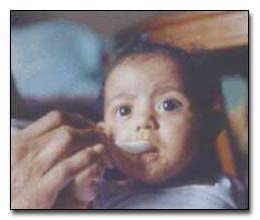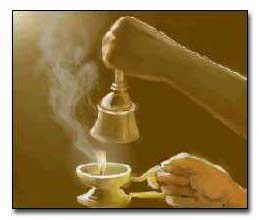


India is a country of beliefs,ceremonies,rituals and festivals and every state has different shades of these customs.The beliefs and rituals of West Bengal are very unique to the state.
The blare of conchshells, children beating on winnows, a pigtailed Brahmin priest squishing bananas into a bowl of milk - there was a method to the seeming madness of these rites and ceremonies prescribed for pregnant mothers down through the centuries. There are almost as many birthing customs as there are dialects in India. One of the most popular customs is the ritual of swad (taste or longing), which revolves around a lunch, and is held in the ninth month of pregnancy, on a day set aside forthe purpose in the panjika (almanac of auspicious days).
The expectant mother wears an elaborate new sari and jewelry given to her for the occasion by the swad's hostess. Specially prescribed food is set out in front of her on a huge silver platter including a cooked fish's head -- one of the most auspicious foods in the Bengali calendar of rituals -- five types of fried food, including banana fritters -- the banana is also auspicious -- and
a mix of vegetables called shukto. The first mouthful that she takes has to include a pinch of everything on the platter and as she puts it into her mouth,the conchshells blow alerting the Gods that the swad has begun and a future mother is now under their care. The mother's meal ends with payesh, a sweetened dish of rice and condensed milk Such rituals aside, childbirth calls for cheating the gods and make them believe no baby is expected, so ensuring a safer delivery. There are so no overt signs of preparation made for the baby; no new clothes bought or bedding made.
From birth up to age three all babies have their foreheads smudged with kajal (charcoal) since black averts the evil eye. After a session of excessive compliments, the baby's maid might burn chilies in a brazier sending out clouds of stinging smoke to blind the eyes of the evil gods and send them scurrying away. As soon as the baby's birth time has been accurately documented, a horoscope is cast. If the stars predict ill luck, a gold talisman filled with sacred herbs is tied around the baby's wrist with a matching amulet for the mother. The baby also wears an iron bangle around its wrist symbolizing protection and strength.
The last birth ritual is the annaprashan (rice eating ceremony) when the baby is six or seven months old and first allowed to eat human food. The baby, formally dressed as a bride or a bridegroom, sits on the mother's lap and is offered a tray which contains certain ritual objects: a lump of earth, a sacred book, a pen and a silver coin. If the baby first picks up the pen it means that he/she will be fond of studies; the earth signifies fertility and prosperity, the money wealth and the sacred book religion. After a puja, the baby's mother dips a gold ring in a bowl of payesh and the ring is given to the baby to suck. This is followed by tiny pinches of fish, shukto and sweetened yogurt.
These ceremonies take place during the day. At night, guests are invited to dinner and the baby is introduced to the wider world of society. With this last ceremony mother and child are firmly settled in the world and free to lead their lives as they please. In Bengali weddings, both the bride’s and the groom’s Mothers do not witness the wedding ceremony, as it is widely believed that their viewing may affect the couples marital life in the form of an ‘evil eye’.
In the case of death rituals among Bengalis, when death is imminent the person is administered a few drops of Ganga jal by the son or a close relative. After death the body is bathed and clothed in white except for a woman survived by her husband who is dressed in a coloured sari. Before the body is taken to the cremation ground the foot impression of the deceased is taken with red ink on a piece of paper. The body is then carried to the cremation ground for the funeral. It is then kept on a pyre. The priest after whom the eldest son of the deceased circles the pyre seven times then performs a pindo daan. Then he lights the pyre to the chant of mantras. This is called Daho Sanskar. Then the remains are collected and kept in a matki. These are brought home and purified with milk, curd, etc. and made into a ball. This ball is then immersed in the water in a matki. This is called Asthi Bisorjan. No cooking is done in the house for three days.
The family members consume simple food, for a few days after the death. A shradh is performed on the 11th day. It is performed every month till the 14th month a shradh is observed. One year from the time of death, Dahoashoucho is observed. Close relatives of the deceased do not celebrate any occasion or festivals.
